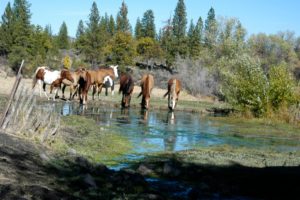
After the devastating toxicity of 2018 wildfire smoke struck our local communities, including my own family, I redoubled my own efforts to help eliminate wildfire and its deadly smoke. During the 9-days I was providing assistance as ‘local knowledge’ on the Klamathon wildfire fire line, I saw many trees that survived that blazing inferno only because the local wild horses had grazed off the fuel from under these trees as well as having broken off all the low-hanging fire ladders.
So talking turned to action. I reached out to our friend Craig C. Downer who happens to be a wildlife biologist, and who like Laura and I, also studies wild horses and who had at one point in his career worked for the BLM on their wild horse program.
On Oct. 11th, we began a cooperative research study of the Natural Wildfire Abatement And Forest Protection Plan, also known as the Wild Horse Fire Brigade. Here are the basics:
Ecosystem-study: To determine the suitability of the pilot-project called Wild Horse Fire Brigade, I evaluated the fauna and flora on the California side of the Soda Mountain Wilderness Area. My review found few large-bodied herbivores. Therefore, it was not surprising that excess vegetation has become established throughout this remote, rugged terrain. Although wild horses are present, their numbers are below the ecosystem’s carrying capacity, likely due to the abundance of mountain lions and coyotes. The current stocking-density is 1 horse per 250 acres. However, the land can easily support 1 horse per 30-to-50 acres. Water-sources are sufficient, even at higher elevations. Despite their low numbers, these privately-owned wild horses are grazing down the vegetation, especially under conifers and oaks.
No Smoke: Wild horses offer a smoke-free way of reducing ground-fuels. Just one wild horse can abate more than 5 tons of senescent grass and brush every year without risk of fire. Contrast such preventive grazing with prescribed burning or, in other words, pre-grazing v. pre-burning. Burns inflict immediate damage on the ecosystem. The fires can spread out of control. They also produce copious smoke. Smoke-exposure is particularly toxic to children, the elderly, and those with heart or lung conditions. Research shows a correlation between smoke-exposure and autoimmune and neurodegenerative disorders.
Cost Advantage: Wild horses graze for free year round. They are the no-cost option. Prescribed burns cost taxpayers $400 an acre and must be repeated every year.
Economic Boon: Wild horses are tourist-magnets. Your area could become an eco-tourist destination. Visitors would spend dollars at local restaurants, motels, and retail shops. Jobs would be created. Better to be visited by photographers than by fire-fighters!
Here are four advantages you have over the competition for market-share:
1. Unique angle: The Siskiyou Wild Horse Fire Brigade would be the first pilot-project to demonstrate wild horses’ natural fire-prevention role. Visitors would learn about this and other benefits that wild horses impart to the environment, such as improving soil-conditions and reseeding native vegetation.
2. Easy-access angle: Visitors to herd management areas often complain that they can’t find any horses. However, during my inspections of the Simpson ranch, I regularly observed wild horses. Such encounters happened even during brief stops, often without my needing to exit my vehicle. Thus, you offer easy access, whether by vehicle or on foot, and a high probability of sighting wild horses.
3. Historic angle: Cultural and paleontological evidence shows that wild horses have inhabited the Soda Mountain Wilderness of Southern Oregon and Northern California for millennia. New research into Native American history evidences a pre-colombian horse-culture in the Americas.
4. Scenic angle: Wild horses enhance the viewshed. Promotional materials use the word “breathtaking” to describe them. Your beautiful landscape and beautiful wild horses are powerful draws.
A full discussion of the pilot can be found here:
http://www.myoutdoorbuddy.com/articles/139528/re-balancing-the-ecosystem:-good-for-outdoor-sports;-reduces-wildfires-and-toxic-smoke.php
For these reasons, I enthusiastically support the Wild Horse Fire Brigade project.
Thank you.
Craig C.Downer – Wildlife Biologist
